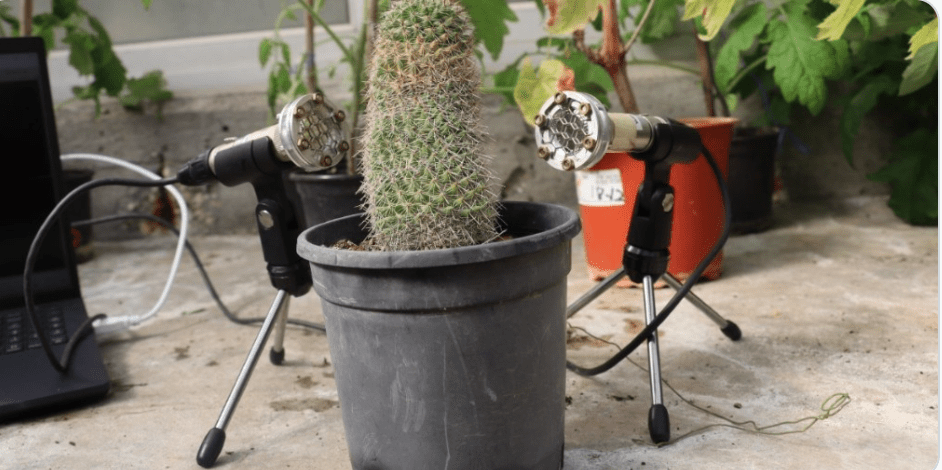Plants “Scream” When Under Stress – Just Like Us
By Rebecca Ann Hughs

Although they might not be audible to human ears, plants do make noises. How fascinating, right?
Researchers in Israel found that plants make a high-frequency clicking sound when placed under stress. Their findings were published this week in the peer-reviewed journal Cell Press.
During a six-year study, the researchers listened to a variety of plants including tomatoes, grapevines, tobacco and wheat.
Do plants communicate through sound?
The plants made noises when they were cut or when they were thirsty.
The sound created wasn’t detectable by the human ear. However, researchers say it sounds a bit like a pop of popcorn or bubble wrap. Furthermore, they make more sounds when they are dry or their stems have been cut.
The researchers say more analysis needs to be done to find out why.
“We found that plants usually emit sounds when they are under stress and that each plant and each type of stress is associated with a specific identifiable sound,” researchers said. “While imperceptible to the human ear, the sounds emitted by plants can probably be heard by various animals, such as bats, mice, and insects.”
How did researchers record the sound of plants?
The researchers used microphones to record healthy and stressed plants.
“We recorded the sounds emitted by plants, we used mostly tomato and tobacco, but we also recorded wheat corn, grapevine, cacti,” says lead author Lilach Hadany.
Hadany explains that the team used different methods to distress the plants.
“We used mostly two stresses, drying the plant and cutting it with scissors, and in both cases they emit sounds. During dehydration, if we stop watering the plant, it started emitting a sound, about day two it peaks.”
The recordings were made in a soundproofed acoustic chamber with a greenhouse environment.
After recording the plants, the researchers trained a machine-learning algorithm to differentiate between unstressed plants, thirsty plants and cut plants.
They took several examples of the ultrasonic sounds, compiled them in a small time frame and changed the frequency so it was audible to human hearing.
According to Hadany, who is an evolutionary biologist, ultrasonic vibrations have been recorded from plants before, but not when transmitted through the air.
Do plants communicate through sound?
The scientists believe further research could reveal more about how plants interact with their environment.
Hadany says just because we can’t hear plants, it doesn’t mean that they are silent to other forms of life.
Insects like moths, or mammals such as mice bats, can hear plants. But the reason why plants make a noise is “an exciting question that is not yet clear.”
“There are two options, the exciting direction is that it is used for communication, but there is also the option that the sounds are a byproduct of physiological processes,” explains Hadany.
What’s also not yet clear is whether the sound-emitting plants are hoping to distract predators or attract pollinators.
“So we can think of a female moth intending to lay eggs. It can lay eggs on a tomato, and now there are several tomato bushes, some of them are emitting sound and others are not,” Hadany says.
“Would it prefer the ones that emit sounds or the ones that do not? This is something we’re looking at, at the moment.”
“Unstressed plants emitted less than one sound per hour, on average while the stressed plants – both dehydrated and injured – emitted dozens of sounds every hour,” researcher Lilach Hadany said.
However, when the plants reached the peak of dehydration, the sounds would stop.
“Our findings suggest that the world around us is full of plant sounds, and that these sounds contain information – for example about water scarcity or injury,” Hadany said. “We assume that in nature the sounds emitted by plants are detected by creatures nearby, such as bats, rodents, various insects, and possibly also other plants – that can hear the high frequencies and derive relevant information.”
Scientists want to apply this knowledge to agriculture and farming to better care for crops. Hadany says they just need the “right tools – such as sensors that tell growers when plants need watering.”
According to the study, “more precise irrigation can save up to 50% of the water expenditure and increase the yield.”
“Apparently, an idyllic field of flowers can be a rather noisy place,” Hadany said. “It’s just that we can’t hear the sounds.”
We already know how adaptive plants can be as evidenced in the discovery of a daisy in South Africa that changed its genes to attract flies.
This is yet another example of how fascinating plants and flowers can be and how they can teach us so much.

